People Management Report: Leadership, Talent, and Training in NHS
VerifiedAdded on 2023/01/16
|10
|2642
|94
Report
AI Summary
This report provides a comprehensive analysis of people management within the National Health Service (NHS). It begins with an introduction to the core concepts, emphasizing the importance of recruitment, compensation, and organizational development. The main body delves into key theoretical models across three critical areas: leadership and management (using the contingency theory), training and development (utilizing the Instructional System Development Model), and talent management (applying a talent management model). The report outlines the roles and priorities of NHS management, alongside the supporting functions of HR, including employee relations, planning, and performance appraisal. It further explores the internal and external influences impacting leadership, training, and talent management. Finally, the report offers recommendations for enhancing leadership, improving training programs, and optimizing talent management strategies to address staff shortages and improve overall service delivery within the NHS.
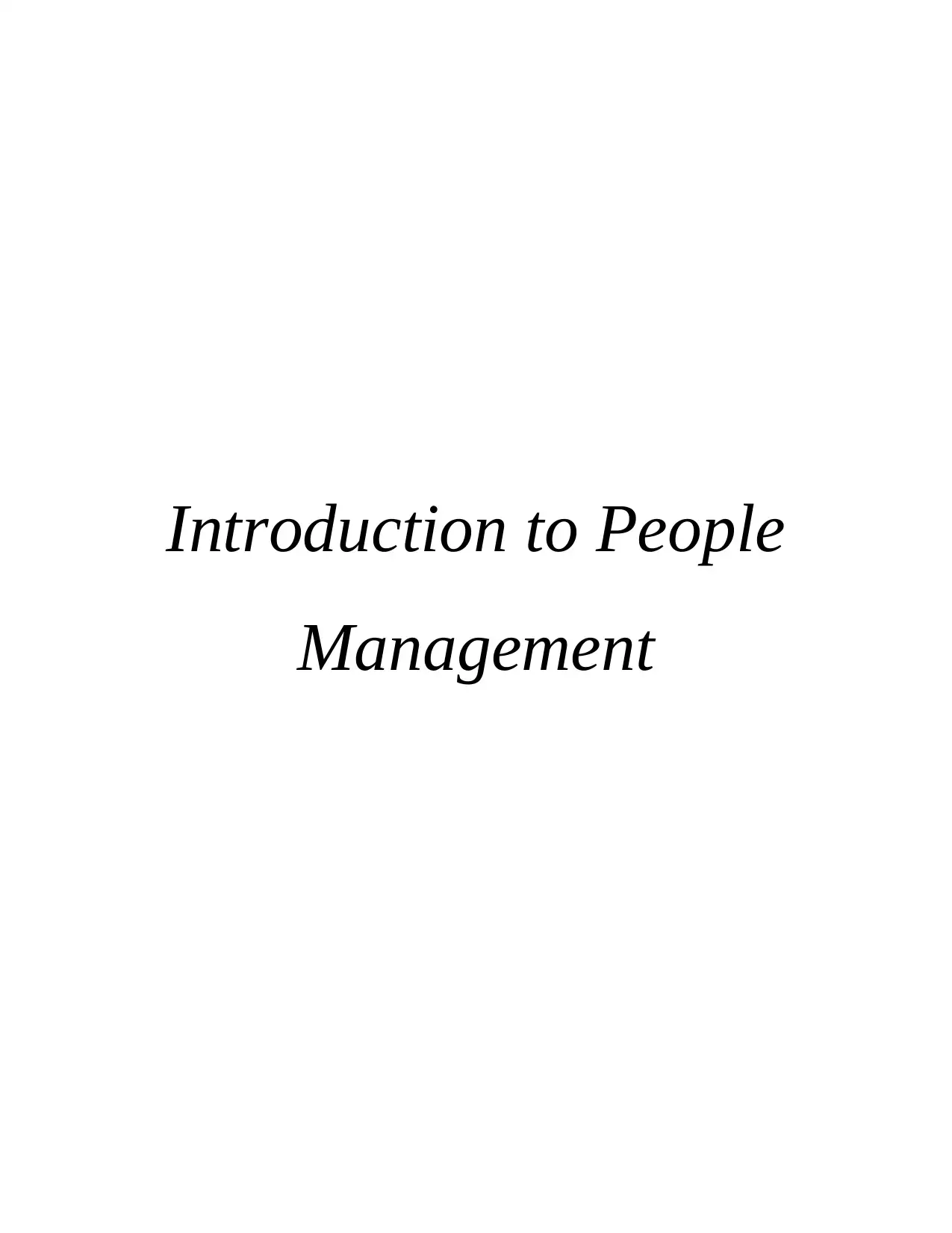
Introduction to People
Management
Management
Paraphrase This Document
Need a fresh take? Get an instant paraphrase of this document with our AI Paraphraser
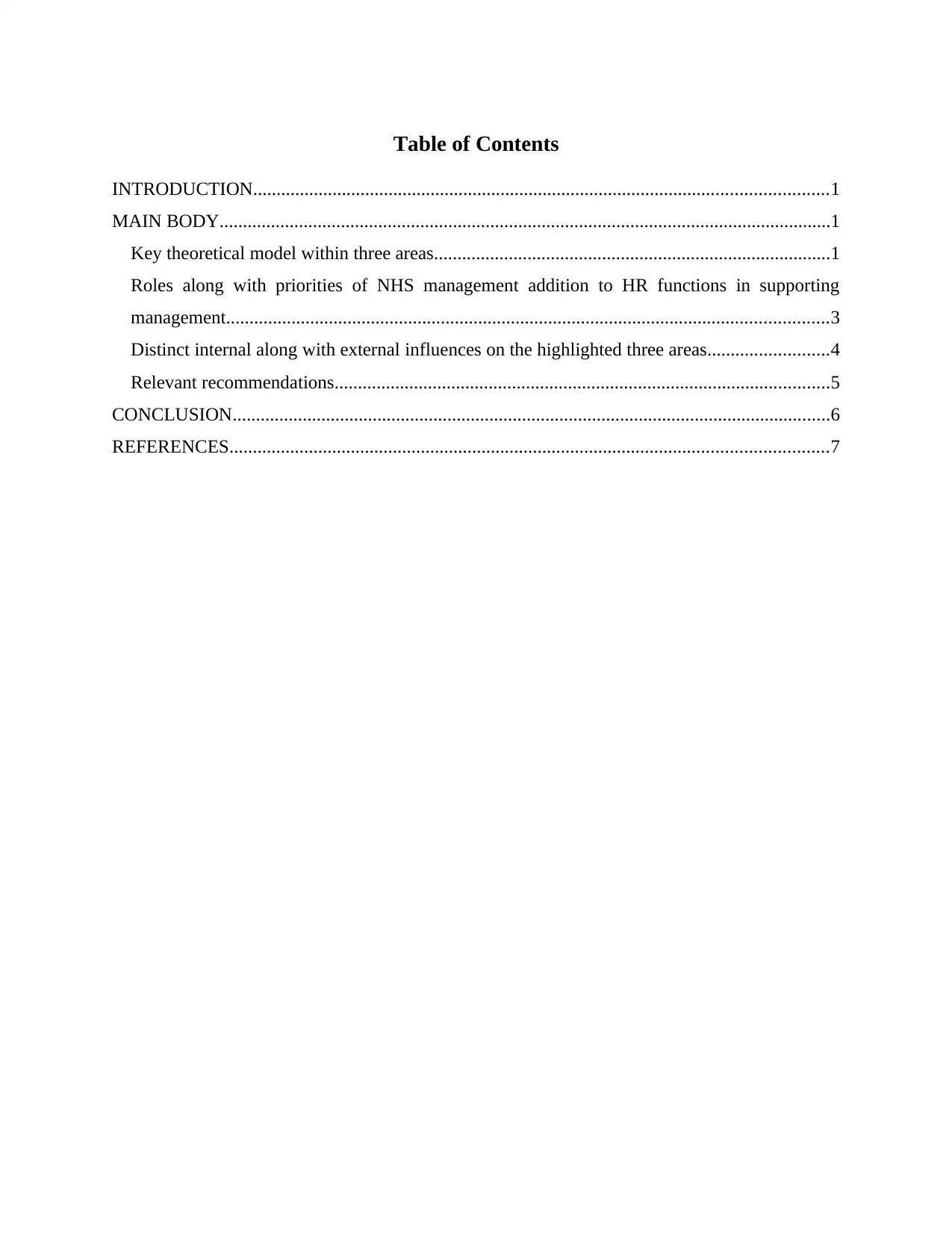
Table of Contents
INTRODUCTION...........................................................................................................................1
MAIN BODY...................................................................................................................................1
Key theoretical model within three areas.....................................................................................1
Roles along with priorities of NHS management addition to HR functions in supporting
management.................................................................................................................................3
Distinct internal along with external influences on the highlighted three areas..........................4
Relevant recommendations..........................................................................................................5
CONCLUSION................................................................................................................................6
REFERENCES................................................................................................................................7
INTRODUCTION...........................................................................................................................1
MAIN BODY...................................................................................................................................1
Key theoretical model within three areas.....................................................................................1
Roles along with priorities of NHS management addition to HR functions in supporting
management.................................................................................................................................3
Distinct internal along with external influences on the highlighted three areas..........................4
Relevant recommendations..........................................................................................................5
CONCLUSION................................................................................................................................6
REFERENCES................................................................................................................................7

⊘ This is a preview!⊘
Do you want full access?
Subscribe today to unlock all pages.

Trusted by 1+ million students worldwide
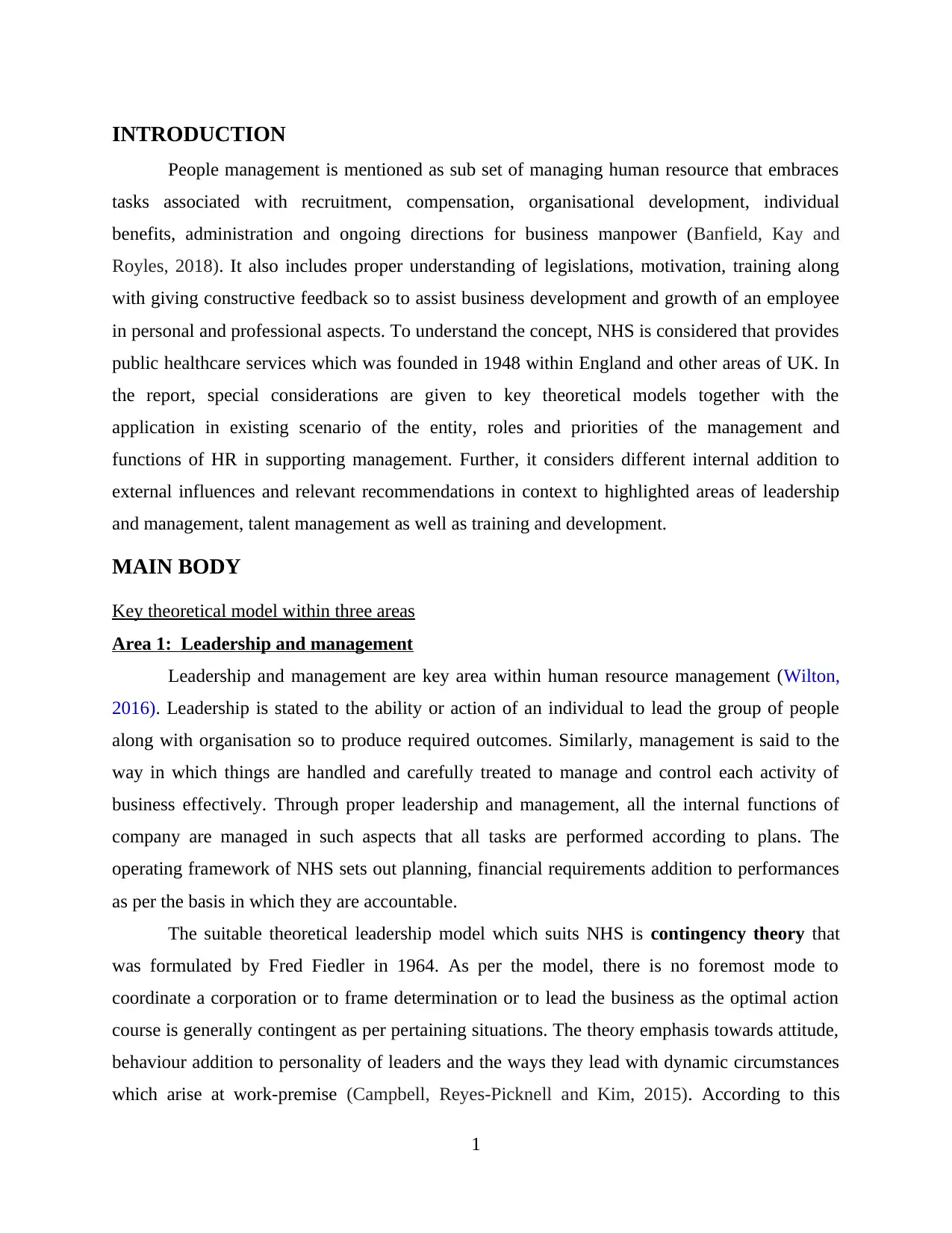
INTRODUCTION
People management is mentioned as sub set of managing human resource that embraces
tasks associated with recruitment, compensation, organisational development, individual
benefits, administration and ongoing directions for business manpower (Banfield, Kay and
Royles, 2018). It also includes proper understanding of legislations, motivation, training along
with giving constructive feedback so to assist business development and growth of an employee
in personal and professional aspects. To understand the concept, NHS is considered that provides
public healthcare services which was founded in 1948 within England and other areas of UK. In
the report, special considerations are given to key theoretical models together with the
application in existing scenario of the entity, roles and priorities of the management and
functions of HR in supporting management. Further, it considers different internal addition to
external influences and relevant recommendations in context to highlighted areas of leadership
and management, talent management as well as training and development.
MAIN BODY
Key theoretical model within three areas
Area 1: Leadership and management
Leadership and management are key area within human resource management (Wilton,
2016). Leadership is stated to the ability or action of an individual to lead the group of people
along with organisation so to produce required outcomes. Similarly, management is said to the
way in which things are handled and carefully treated to manage and control each activity of
business effectively. Through proper leadership and management, all the internal functions of
company are managed in such aspects that all tasks are performed according to plans. The
operating framework of NHS sets out planning, financial requirements addition to performances
as per the basis in which they are accountable.
The suitable theoretical leadership model which suits NHS is contingency theory that
was formulated by Fred Fiedler in 1964. As per the model, there is no foremost mode to
coordinate a corporation or to frame determination or to lead the business as the optimal action
course is generally contingent as per pertaining situations. The theory emphasis towards attitude,
behaviour addition to personality of leaders and the ways they lead with dynamic circumstances
which arise at work-premise (Campbell, Reyes-Picknell and Kim, 2015). According to this
1
People management is mentioned as sub set of managing human resource that embraces
tasks associated with recruitment, compensation, organisational development, individual
benefits, administration and ongoing directions for business manpower (Banfield, Kay and
Royles, 2018). It also includes proper understanding of legislations, motivation, training along
with giving constructive feedback so to assist business development and growth of an employee
in personal and professional aspects. To understand the concept, NHS is considered that provides
public healthcare services which was founded in 1948 within England and other areas of UK. In
the report, special considerations are given to key theoretical models together with the
application in existing scenario of the entity, roles and priorities of the management and
functions of HR in supporting management. Further, it considers different internal addition to
external influences and relevant recommendations in context to highlighted areas of leadership
and management, talent management as well as training and development.
MAIN BODY
Key theoretical model within three areas
Area 1: Leadership and management
Leadership and management are key area within human resource management (Wilton,
2016). Leadership is stated to the ability or action of an individual to lead the group of people
along with organisation so to produce required outcomes. Similarly, management is said to the
way in which things are handled and carefully treated to manage and control each activity of
business effectively. Through proper leadership and management, all the internal functions of
company are managed in such aspects that all tasks are performed according to plans. The
operating framework of NHS sets out planning, financial requirements addition to performances
as per the basis in which they are accountable.
The suitable theoretical leadership model which suits NHS is contingency theory that
was formulated by Fred Fiedler in 1964. As per the model, there is no foremost mode to
coordinate a corporation or to frame determination or to lead the business as the optimal action
course is generally contingent as per pertaining situations. The theory emphasis towards attitude,
behaviour addition to personality of leaders and the ways they lead with dynamic circumstances
which arise at work-premise (Campbell, Reyes-Picknell and Kim, 2015). According to this
1
Paraphrase This Document
Need a fresh take? Get an instant paraphrase of this document with our AI Paraphraser
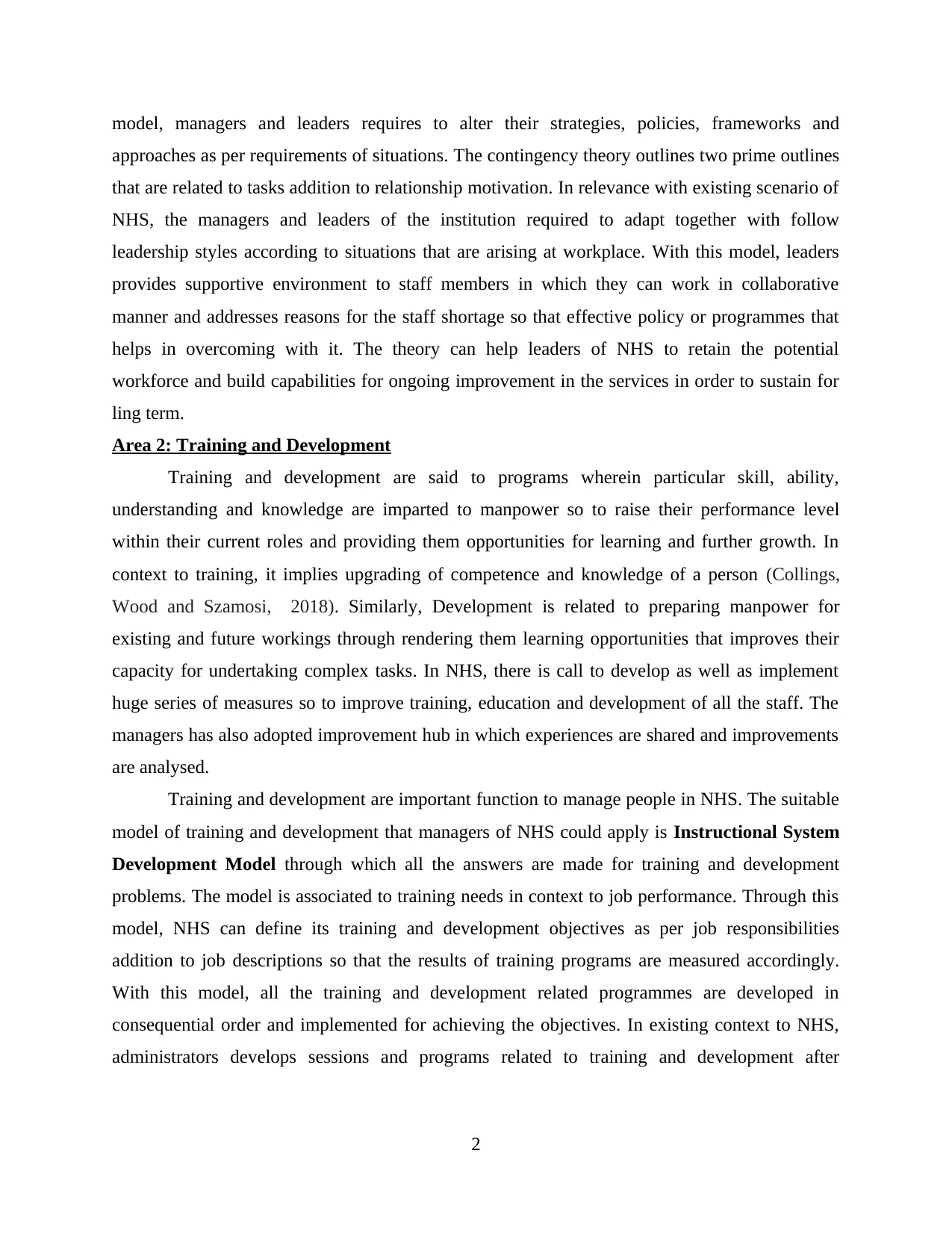
model, managers and leaders requires to alter their strategies, policies, frameworks and
approaches as per requirements of situations. The contingency theory outlines two prime outlines
that are related to tasks addition to relationship motivation. In relevance with existing scenario of
NHS, the managers and leaders of the institution required to adapt together with follow
leadership styles according to situations that are arising at workplace. With this model, leaders
provides supportive environment to staff members in which they can work in collaborative
manner and addresses reasons for the staff shortage so that effective policy or programmes that
helps in overcoming with it. The theory can help leaders of NHS to retain the potential
workforce and build capabilities for ongoing improvement in the services in order to sustain for
ling term.
Area 2: Training and Development
Training and development are said to programs wherein particular skill, ability,
understanding and knowledge are imparted to manpower so to raise their performance level
within their current roles and providing them opportunities for learning and further growth. In
context to training, it implies upgrading of competence and knowledge of a person (Collings,
Wood and Szamosi, 2018). Similarly, Development is related to preparing manpower for
existing and future workings through rendering them learning opportunities that improves their
capacity for undertaking complex tasks. In NHS, there is call to develop as well as implement
huge series of measures so to improve training, education and development of all the staff. The
managers has also adopted improvement hub in which experiences are shared and improvements
are analysed.
Training and development are important function to manage people in NHS. The suitable
model of training and development that managers of NHS could apply is Instructional System
Development Model through which all the answers are made for training and development
problems. The model is associated to training needs in context to job performance. Through this
model, NHS can define its training and development objectives as per job responsibilities
addition to job descriptions so that the results of training programs are measured accordingly.
With this model, all the training and development related programmes are developed in
consequential order and implemented for achieving the objectives. In existing context to NHS,
administrators develops sessions and programs related to training and development after
2
approaches as per requirements of situations. The contingency theory outlines two prime outlines
that are related to tasks addition to relationship motivation. In relevance with existing scenario of
NHS, the managers and leaders of the institution required to adapt together with follow
leadership styles according to situations that are arising at workplace. With this model, leaders
provides supportive environment to staff members in which they can work in collaborative
manner and addresses reasons for the staff shortage so that effective policy or programmes that
helps in overcoming with it. The theory can help leaders of NHS to retain the potential
workforce and build capabilities for ongoing improvement in the services in order to sustain for
ling term.
Area 2: Training and Development
Training and development are said to programs wherein particular skill, ability,
understanding and knowledge are imparted to manpower so to raise their performance level
within their current roles and providing them opportunities for learning and further growth. In
context to training, it implies upgrading of competence and knowledge of a person (Collings,
Wood and Szamosi, 2018). Similarly, Development is related to preparing manpower for
existing and future workings through rendering them learning opportunities that improves their
capacity for undertaking complex tasks. In NHS, there is call to develop as well as implement
huge series of measures so to improve training, education and development of all the staff. The
managers has also adopted improvement hub in which experiences are shared and improvements
are analysed.
Training and development are important function to manage people in NHS. The suitable
model of training and development that managers of NHS could apply is Instructional System
Development Model through which all the answers are made for training and development
problems. The model is associated to training needs in context to job performance. Through this
model, NHS can define its training and development objectives as per job responsibilities
addition to job descriptions so that the results of training programs are measured accordingly.
With this model, all the training and development related programmes are developed in
consequential order and implemented for achieving the objectives. In existing context to NHS,
administrators develops sessions and programs related to training and development after
2
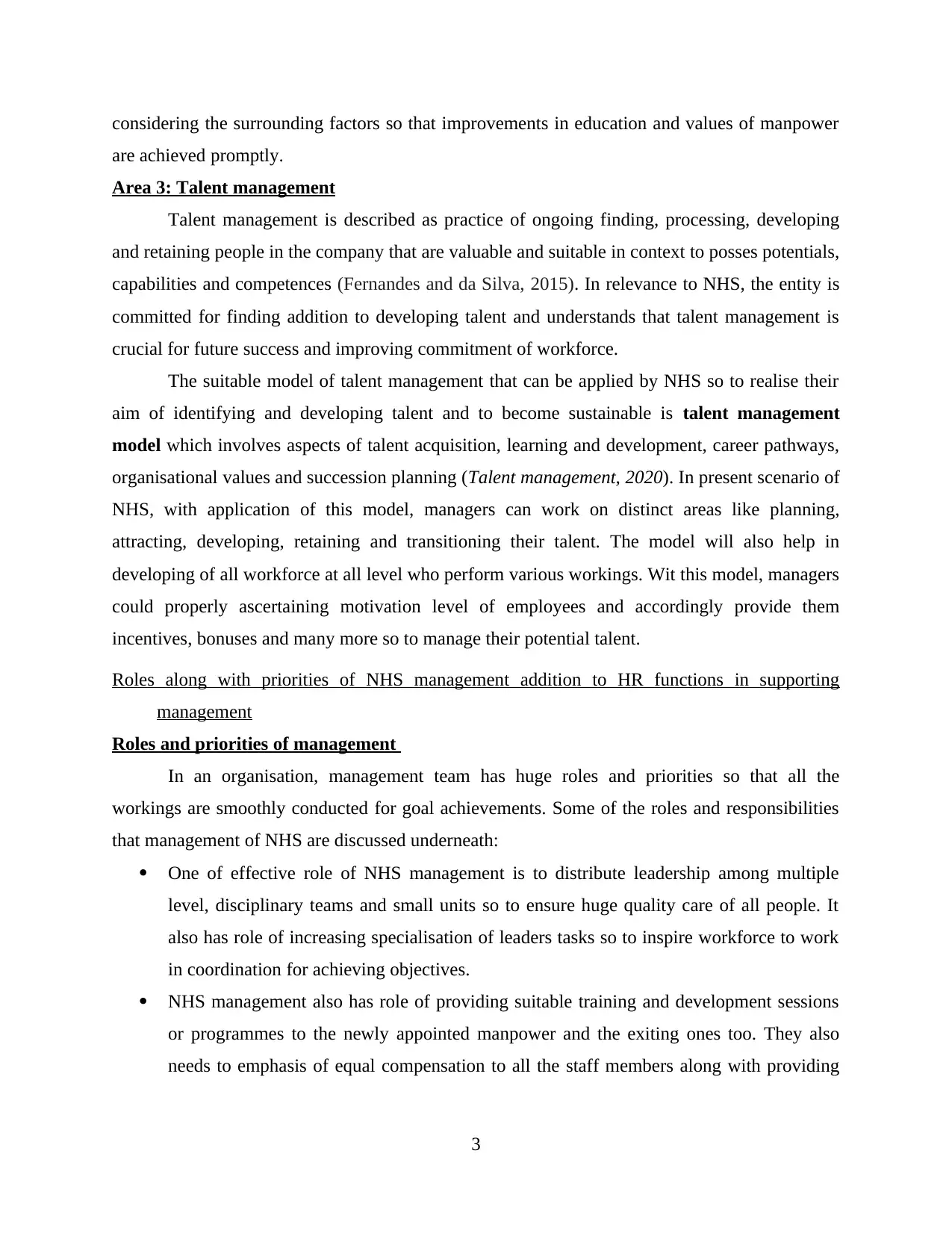
considering the surrounding factors so that improvements in education and values of manpower
are achieved promptly.
Area 3: Talent management
Talent management is described as practice of ongoing finding, processing, developing
and retaining people in the company that are valuable and suitable in context to posses potentials,
capabilities and competences (Fernandes and da Silva, 2015). In relevance to NHS, the entity is
committed for finding addition to developing talent and understands that talent management is
crucial for future success and improving commitment of workforce.
The suitable model of talent management that can be applied by NHS so to realise their
aim of identifying and developing talent and to become sustainable is talent management
model which involves aspects of talent acquisition, learning and development, career pathways,
organisational values and succession planning (Talent management, 2020). In present scenario of
NHS, with application of this model, managers can work on distinct areas like planning,
attracting, developing, retaining and transitioning their talent. The model will also help in
developing of all workforce at all level who perform various workings. Wit this model, managers
could properly ascertaining motivation level of employees and accordingly provide them
incentives, bonuses and many more so to manage their potential talent.
Roles along with priorities of NHS management addition to HR functions in supporting
management
Roles and priorities of management
In an organisation, management team has huge roles and priorities so that all the
workings are smoothly conducted for goal achievements. Some of the roles and responsibilities
that management of NHS are discussed underneath:
One of effective role of NHS management is to distribute leadership among multiple
level, disciplinary teams and small units so to ensure huge quality care of all people. It
also has role of increasing specialisation of leaders tasks so to inspire workforce to work
in coordination for achieving objectives.
NHS management also has role of providing suitable training and development sessions
or programmes to the newly appointed manpower and the exiting ones too. They also
needs to emphasis of equal compensation to all the staff members along with providing
3
are achieved promptly.
Area 3: Talent management
Talent management is described as practice of ongoing finding, processing, developing
and retaining people in the company that are valuable and suitable in context to posses potentials,
capabilities and competences (Fernandes and da Silva, 2015). In relevance to NHS, the entity is
committed for finding addition to developing talent and understands that talent management is
crucial for future success and improving commitment of workforce.
The suitable model of talent management that can be applied by NHS so to realise their
aim of identifying and developing talent and to become sustainable is talent management
model which involves aspects of talent acquisition, learning and development, career pathways,
organisational values and succession planning (Talent management, 2020). In present scenario of
NHS, with application of this model, managers can work on distinct areas like planning,
attracting, developing, retaining and transitioning their talent. The model will also help in
developing of all workforce at all level who perform various workings. Wit this model, managers
could properly ascertaining motivation level of employees and accordingly provide them
incentives, bonuses and many more so to manage their potential talent.
Roles along with priorities of NHS management addition to HR functions in supporting
management
Roles and priorities of management
In an organisation, management team has huge roles and priorities so that all the
workings are smoothly conducted for goal achievements. Some of the roles and responsibilities
that management of NHS are discussed underneath:
One of effective role of NHS management is to distribute leadership among multiple
level, disciplinary teams and small units so to ensure huge quality care of all people. It
also has role of increasing specialisation of leaders tasks so to inspire workforce to work
in coordination for achieving objectives.
NHS management also has role of providing suitable training and development sessions
or programmes to the newly appointed manpower and the exiting ones too. They also
needs to emphasis of equal compensation to all the staff members along with providing
3
⊘ This is a preview!⊘
Do you want full access?
Subscribe today to unlock all pages.

Trusted by 1+ million students worldwide
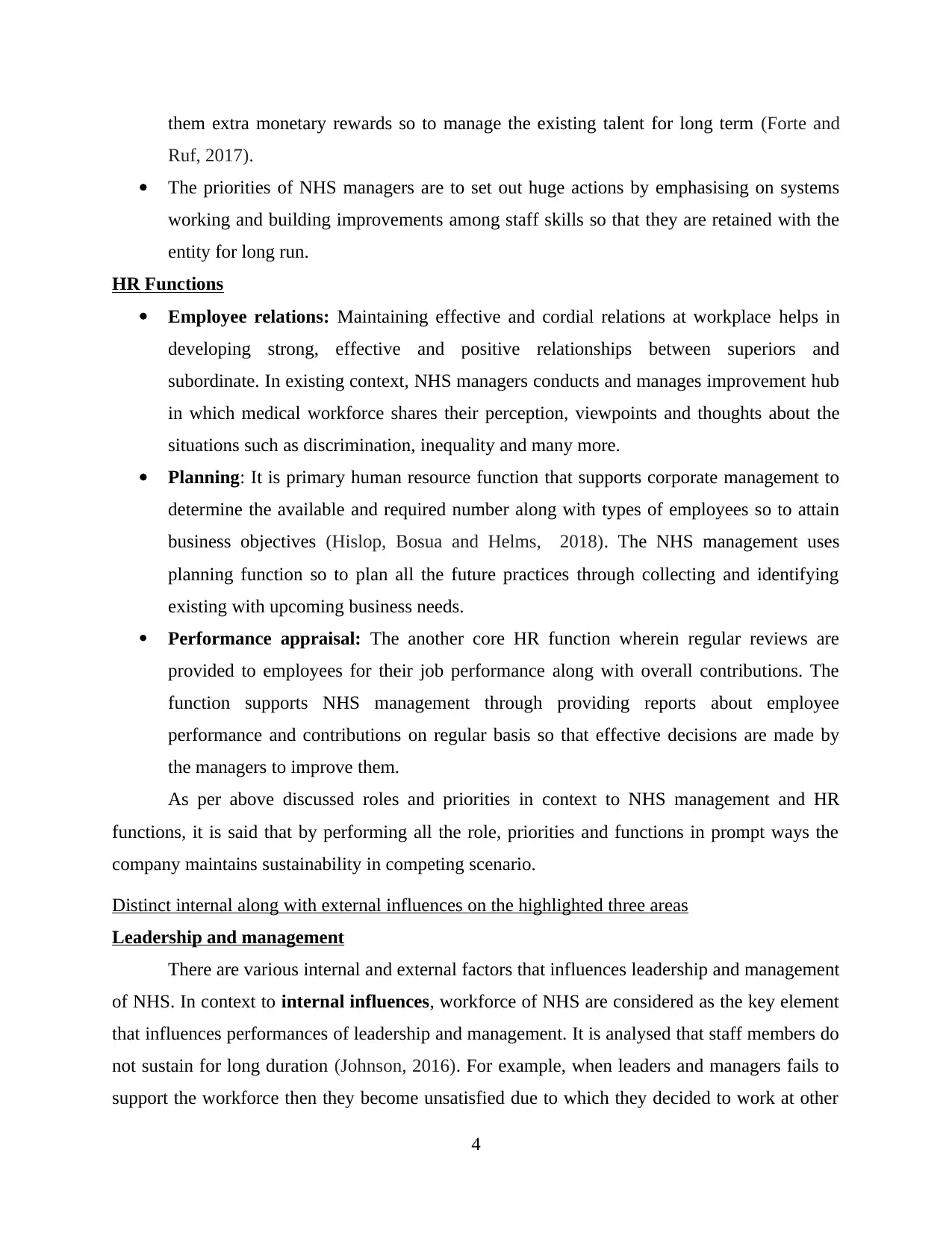
them extra monetary rewards so to manage the existing talent for long term (Forte and
Ruf, 2017).
The priorities of NHS managers are to set out huge actions by emphasising on systems
working and building improvements among staff skills so that they are retained with the
entity for long run.
HR Functions
Employee relations: Maintaining effective and cordial relations at workplace helps in
developing strong, effective and positive relationships between superiors and
subordinate. In existing context, NHS managers conducts and manages improvement hub
in which medical workforce shares their perception, viewpoints and thoughts about the
situations such as discrimination, inequality and many more.
Planning: It is primary human resource function that supports corporate management to
determine the available and required number along with types of employees so to attain
business objectives (Hislop, Bosua and Helms, 2018). The NHS management uses
planning function so to plan all the future practices through collecting and identifying
existing with upcoming business needs.
Performance appraisal: The another core HR function wherein regular reviews are
provided to employees for their job performance along with overall contributions. The
function supports NHS management through providing reports about employee
performance and contributions on regular basis so that effective decisions are made by
the managers to improve them.
As per above discussed roles and priorities in context to NHS management and HR
functions, it is said that by performing all the role, priorities and functions in prompt ways the
company maintains sustainability in competing scenario.
Distinct internal along with external influences on the highlighted three areas
Leadership and management
There are various internal and external factors that influences leadership and management
of NHS. In context to internal influences, workforce of NHS are considered as the key element
that influences performances of leadership and management. It is analysed that staff members do
not sustain for long duration (Johnson, 2016). For example, when leaders and managers fails to
support the workforce then they become unsatisfied due to which they decided to work at other
4
Ruf, 2017).
The priorities of NHS managers are to set out huge actions by emphasising on systems
working and building improvements among staff skills so that they are retained with the
entity for long run.
HR Functions
Employee relations: Maintaining effective and cordial relations at workplace helps in
developing strong, effective and positive relationships between superiors and
subordinate. In existing context, NHS managers conducts and manages improvement hub
in which medical workforce shares their perception, viewpoints and thoughts about the
situations such as discrimination, inequality and many more.
Planning: It is primary human resource function that supports corporate management to
determine the available and required number along with types of employees so to attain
business objectives (Hislop, Bosua and Helms, 2018). The NHS management uses
planning function so to plan all the future practices through collecting and identifying
existing with upcoming business needs.
Performance appraisal: The another core HR function wherein regular reviews are
provided to employees for their job performance along with overall contributions. The
function supports NHS management through providing reports about employee
performance and contributions on regular basis so that effective decisions are made by
the managers to improve them.
As per above discussed roles and priorities in context to NHS management and HR
functions, it is said that by performing all the role, priorities and functions in prompt ways the
company maintains sustainability in competing scenario.
Distinct internal along with external influences on the highlighted three areas
Leadership and management
There are various internal and external factors that influences leadership and management
of NHS. In context to internal influences, workforce of NHS are considered as the key element
that influences performances of leadership and management. It is analysed that staff members do
not sustain for long duration (Johnson, 2016). For example, when leaders and managers fails to
support the workforce then they become unsatisfied due to which they decided to work at other
4
Paraphrase This Document
Need a fresh take? Get an instant paraphrase of this document with our AI Paraphraser
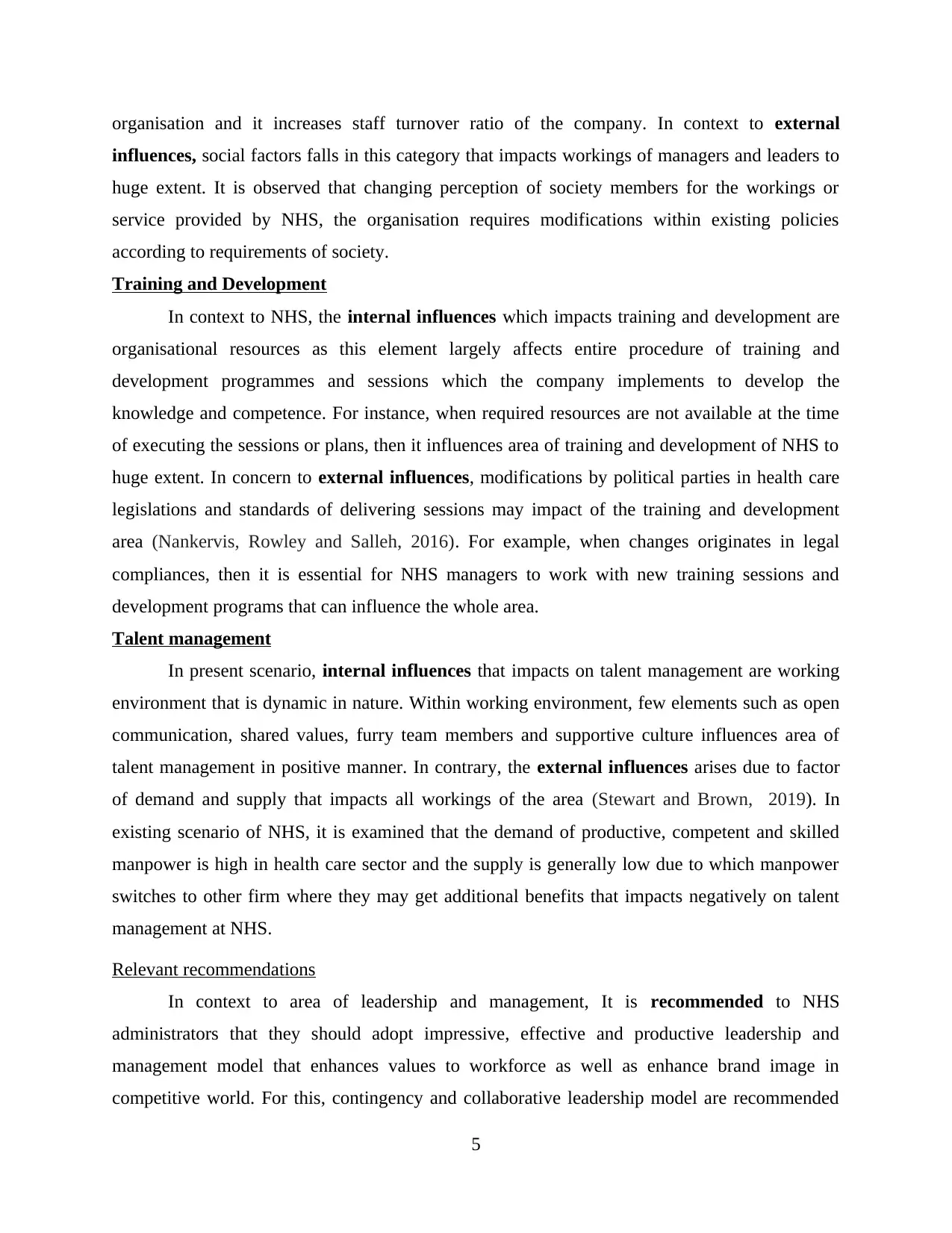
organisation and it increases staff turnover ratio of the company. In context to external
influences, social factors falls in this category that impacts workings of managers and leaders to
huge extent. It is observed that changing perception of society members for the workings or
service provided by NHS, the organisation requires modifications within existing policies
according to requirements of society.
Training and Development
In context to NHS, the internal influences which impacts training and development are
organisational resources as this element largely affects entire procedure of training and
development programmes and sessions which the company implements to develop the
knowledge and competence. For instance, when required resources are not available at the time
of executing the sessions or plans, then it influences area of training and development of NHS to
huge extent. In concern to external influences, modifications by political parties in health care
legislations and standards of delivering sessions may impact of the training and development
area (Nankervis, Rowley and Salleh, 2016). For example, when changes originates in legal
compliances, then it is essential for NHS managers to work with new training sessions and
development programs that can influence the whole area.
Talent management
In present scenario, internal influences that impacts on talent management are working
environment that is dynamic in nature. Within working environment, few elements such as open
communication, shared values, furry team members and supportive culture influences area of
talent management in positive manner. In contrary, the external influences arises due to factor
of demand and supply that impacts all workings of the area (Stewart and Brown, 2019). In
existing scenario of NHS, it is examined that the demand of productive, competent and skilled
manpower is high in health care sector and the supply is generally low due to which manpower
switches to other firm where they may get additional benefits that impacts negatively on talent
management at NHS.
Relevant recommendations
In context to area of leadership and management, It is recommended to NHS
administrators that they should adopt impressive, effective and productive leadership and
management model that enhances values to workforce as well as enhance brand image in
competitive world. For this, contingency and collaborative leadership model are recommended
5
influences, social factors falls in this category that impacts workings of managers and leaders to
huge extent. It is observed that changing perception of society members for the workings or
service provided by NHS, the organisation requires modifications within existing policies
according to requirements of society.
Training and Development
In context to NHS, the internal influences which impacts training and development are
organisational resources as this element largely affects entire procedure of training and
development programmes and sessions which the company implements to develop the
knowledge and competence. For instance, when required resources are not available at the time
of executing the sessions or plans, then it influences area of training and development of NHS to
huge extent. In concern to external influences, modifications by political parties in health care
legislations and standards of delivering sessions may impact of the training and development
area (Nankervis, Rowley and Salleh, 2016). For example, when changes originates in legal
compliances, then it is essential for NHS managers to work with new training sessions and
development programs that can influence the whole area.
Talent management
In present scenario, internal influences that impacts on talent management are working
environment that is dynamic in nature. Within working environment, few elements such as open
communication, shared values, furry team members and supportive culture influences area of
talent management in positive manner. In contrary, the external influences arises due to factor
of demand and supply that impacts all workings of the area (Stewart and Brown, 2019). In
existing scenario of NHS, it is examined that the demand of productive, competent and skilled
manpower is high in health care sector and the supply is generally low due to which manpower
switches to other firm where they may get additional benefits that impacts negatively on talent
management at NHS.
Relevant recommendations
In context to area of leadership and management, It is recommended to NHS
administrators that they should adopt impressive, effective and productive leadership and
management model that enhances values to workforce as well as enhance brand image in
competitive world. For this, contingency and collaborative leadership model are recommended
5
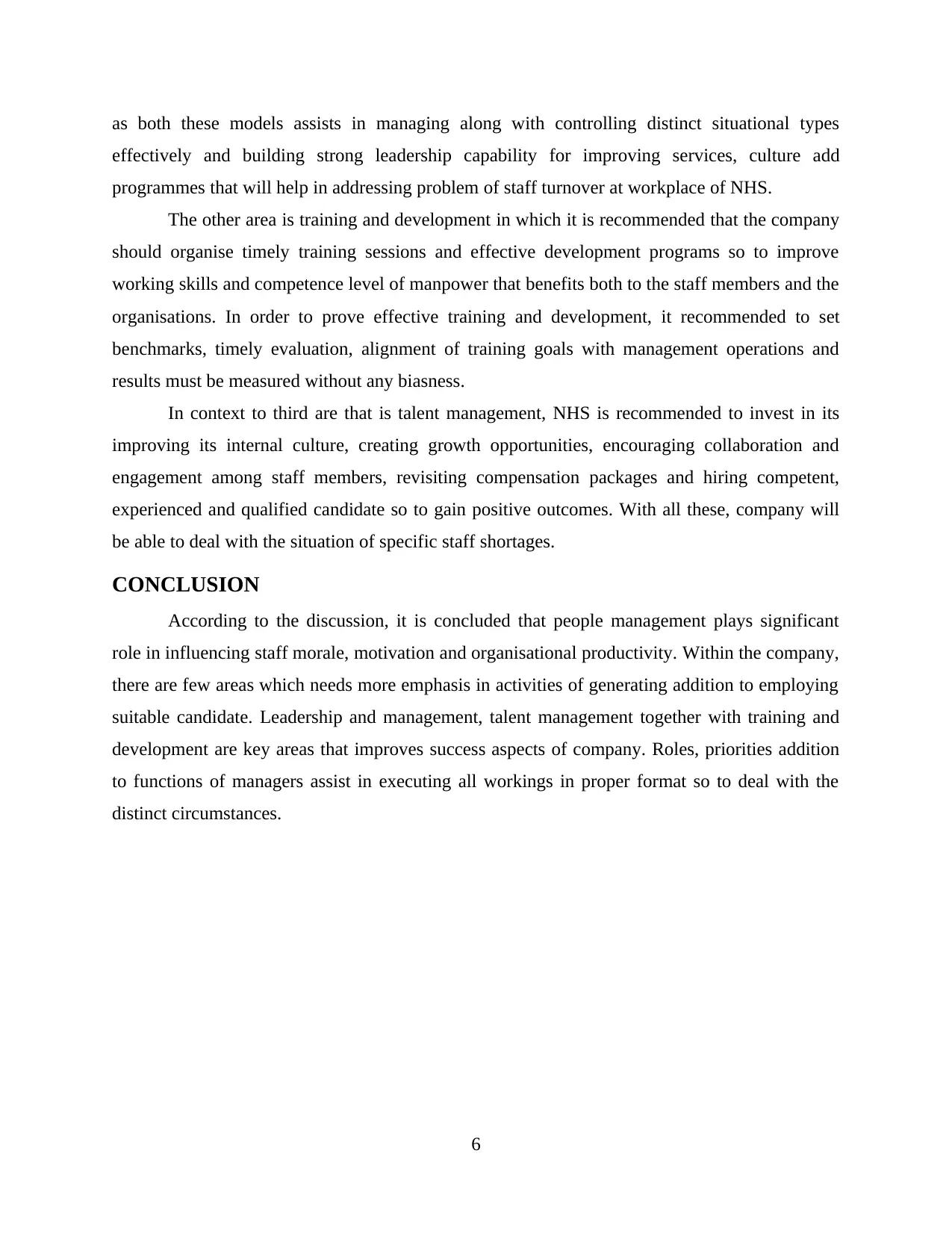
as both these models assists in managing along with controlling distinct situational types
effectively and building strong leadership capability for improving services, culture add
programmes that will help in addressing problem of staff turnover at workplace of NHS.
The other area is training and development in which it is recommended that the company
should organise timely training sessions and effective development programs so to improve
working skills and competence level of manpower that benefits both to the staff members and the
organisations. In order to prove effective training and development, it recommended to set
benchmarks, timely evaluation, alignment of training goals with management operations and
results must be measured without any biasness.
In context to third are that is talent management, NHS is recommended to invest in its
improving its internal culture, creating growth opportunities, encouraging collaboration and
engagement among staff members, revisiting compensation packages and hiring competent,
experienced and qualified candidate so to gain positive outcomes. With all these, company will
be able to deal with the situation of specific staff shortages.
CONCLUSION
According to the discussion, it is concluded that people management plays significant
role in influencing staff morale, motivation and organisational productivity. Within the company,
there are few areas which needs more emphasis in activities of generating addition to employing
suitable candidate. Leadership and management, talent management together with training and
development are key areas that improves success aspects of company. Roles, priorities addition
to functions of managers assist in executing all workings in proper format so to deal with the
distinct circumstances.
6
effectively and building strong leadership capability for improving services, culture add
programmes that will help in addressing problem of staff turnover at workplace of NHS.
The other area is training and development in which it is recommended that the company
should organise timely training sessions and effective development programs so to improve
working skills and competence level of manpower that benefits both to the staff members and the
organisations. In order to prove effective training and development, it recommended to set
benchmarks, timely evaluation, alignment of training goals with management operations and
results must be measured without any biasness.
In context to third are that is talent management, NHS is recommended to invest in its
improving its internal culture, creating growth opportunities, encouraging collaboration and
engagement among staff members, revisiting compensation packages and hiring competent,
experienced and qualified candidate so to gain positive outcomes. With all these, company will
be able to deal with the situation of specific staff shortages.
CONCLUSION
According to the discussion, it is concluded that people management plays significant
role in influencing staff morale, motivation and organisational productivity. Within the company,
there are few areas which needs more emphasis in activities of generating addition to employing
suitable candidate. Leadership and management, talent management together with training and
development are key areas that improves success aspects of company. Roles, priorities addition
to functions of managers assist in executing all workings in proper format so to deal with the
distinct circumstances.
6
⊘ This is a preview!⊘
Do you want full access?
Subscribe today to unlock all pages.

Trusted by 1+ million students worldwide
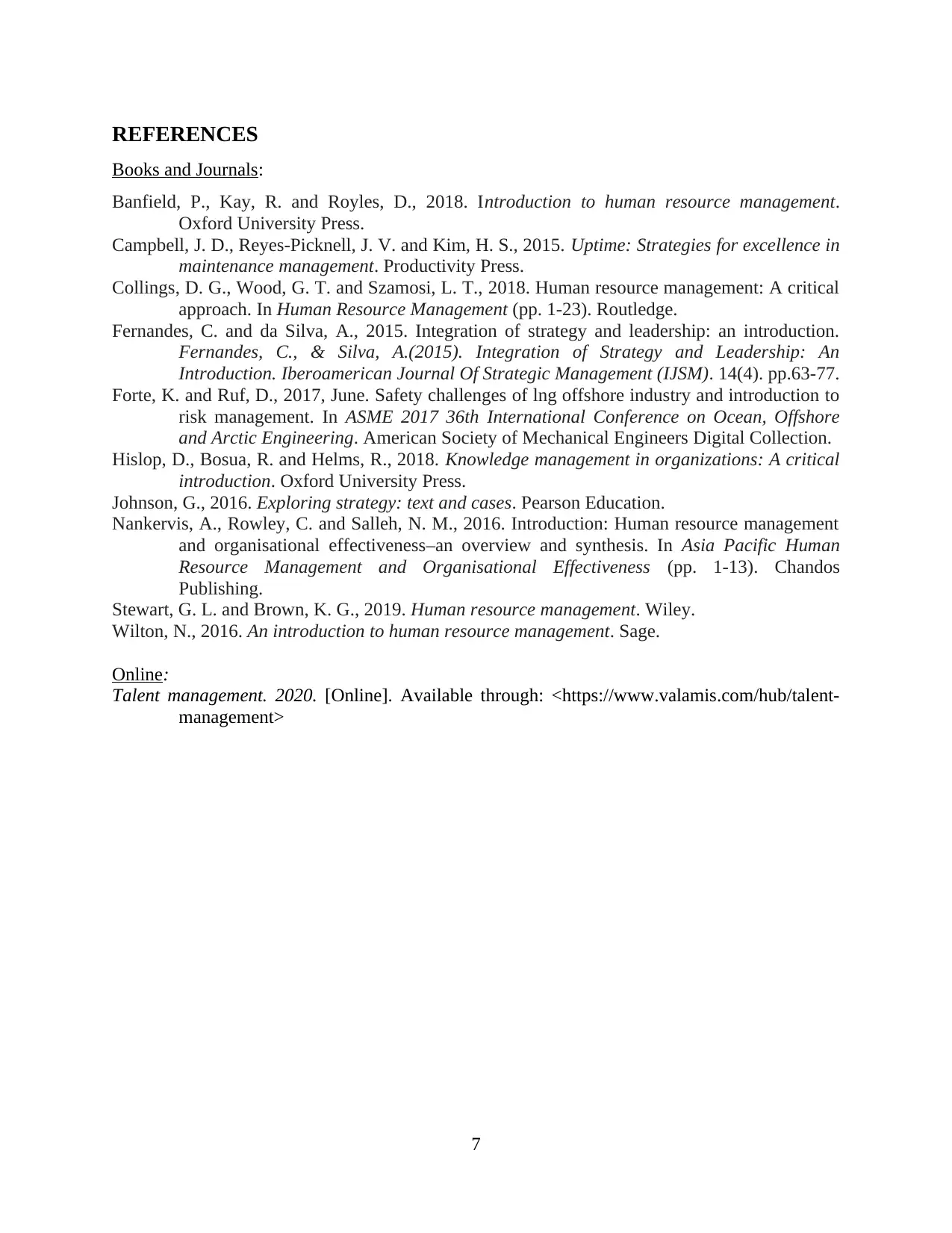
REFERENCES
Books and Journals:
Banfield, P., Kay, R. and Royles, D., 2018. Introduction to human resource management.
Oxford University Press.
Campbell, J. D., Reyes-Picknell, J. V. and Kim, H. S., 2015. Uptime: Strategies for excellence in
maintenance management. Productivity Press.
Collings, D. G., Wood, G. T. and Szamosi, L. T., 2018. Human resource management: A critical
approach. In Human Resource Management (pp. 1-23). Routledge.
Fernandes, C. and da Silva, A., 2015. Integration of strategy and leadership: an introduction.
Fernandes, C., & Silva, A.(2015). Integration of Strategy and Leadership: An
Introduction. Iberoamerican Journal Of Strategic Management (IJSM). 14(4). pp.63-77.
Forte, K. and Ruf, D., 2017, June. Safety challenges of lng offshore industry and introduction to
risk management. In ASME 2017 36th International Conference on Ocean, Offshore
and Arctic Engineering. American Society of Mechanical Engineers Digital Collection.
Hislop, D., Bosua, R. and Helms, R., 2018. Knowledge management in organizations: A critical
introduction. Oxford University Press.
Johnson, G., 2016. Exploring strategy: text and cases. Pearson Education.
Nankervis, A., Rowley, C. and Salleh, N. M., 2016. Introduction: Human resource management
and organisational effectiveness–an overview and synthesis. In Asia Pacific Human
Resource Management and Organisational Effectiveness (pp. 1-13). Chandos
Publishing.
Stewart, G. L. and Brown, K. G., 2019. Human resource management. Wiley.
Wilton, N., 2016. An introduction to human resource management. Sage.
Online:
Talent management. 2020. [Online]. Available through: <https://www.valamis.com/hub/talent-
management>
7
Books and Journals:
Banfield, P., Kay, R. and Royles, D., 2018. Introduction to human resource management.
Oxford University Press.
Campbell, J. D., Reyes-Picknell, J. V. and Kim, H. S., 2015. Uptime: Strategies for excellence in
maintenance management. Productivity Press.
Collings, D. G., Wood, G. T. and Szamosi, L. T., 2018. Human resource management: A critical
approach. In Human Resource Management (pp. 1-23). Routledge.
Fernandes, C. and da Silva, A., 2015. Integration of strategy and leadership: an introduction.
Fernandes, C., & Silva, A.(2015). Integration of Strategy and Leadership: An
Introduction. Iberoamerican Journal Of Strategic Management (IJSM). 14(4). pp.63-77.
Forte, K. and Ruf, D., 2017, June. Safety challenges of lng offshore industry and introduction to
risk management. In ASME 2017 36th International Conference on Ocean, Offshore
and Arctic Engineering. American Society of Mechanical Engineers Digital Collection.
Hislop, D., Bosua, R. and Helms, R., 2018. Knowledge management in organizations: A critical
introduction. Oxford University Press.
Johnson, G., 2016. Exploring strategy: text and cases. Pearson Education.
Nankervis, A., Rowley, C. and Salleh, N. M., 2016. Introduction: Human resource management
and organisational effectiveness–an overview and synthesis. In Asia Pacific Human
Resource Management and Organisational Effectiveness (pp. 1-13). Chandos
Publishing.
Stewart, G. L. and Brown, K. G., 2019. Human resource management. Wiley.
Wilton, N., 2016. An introduction to human resource management. Sage.
Online:
Talent management. 2020. [Online]. Available through: <https://www.valamis.com/hub/talent-
management>
7
1 out of 10
Related Documents
Your All-in-One AI-Powered Toolkit for Academic Success.
+13062052269
info@desklib.com
Available 24*7 on WhatsApp / Email
![[object Object]](/_next/static/media/star-bottom.7253800d.svg)
Unlock your academic potential
Copyright © 2020–2025 A2Z Services. All Rights Reserved. Developed and managed by ZUCOL.




